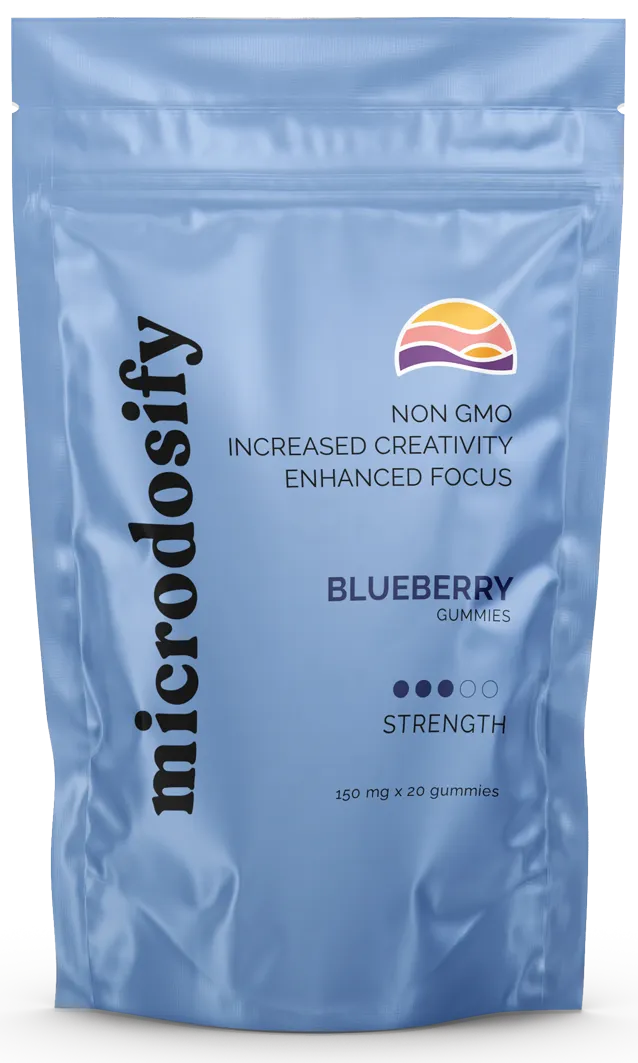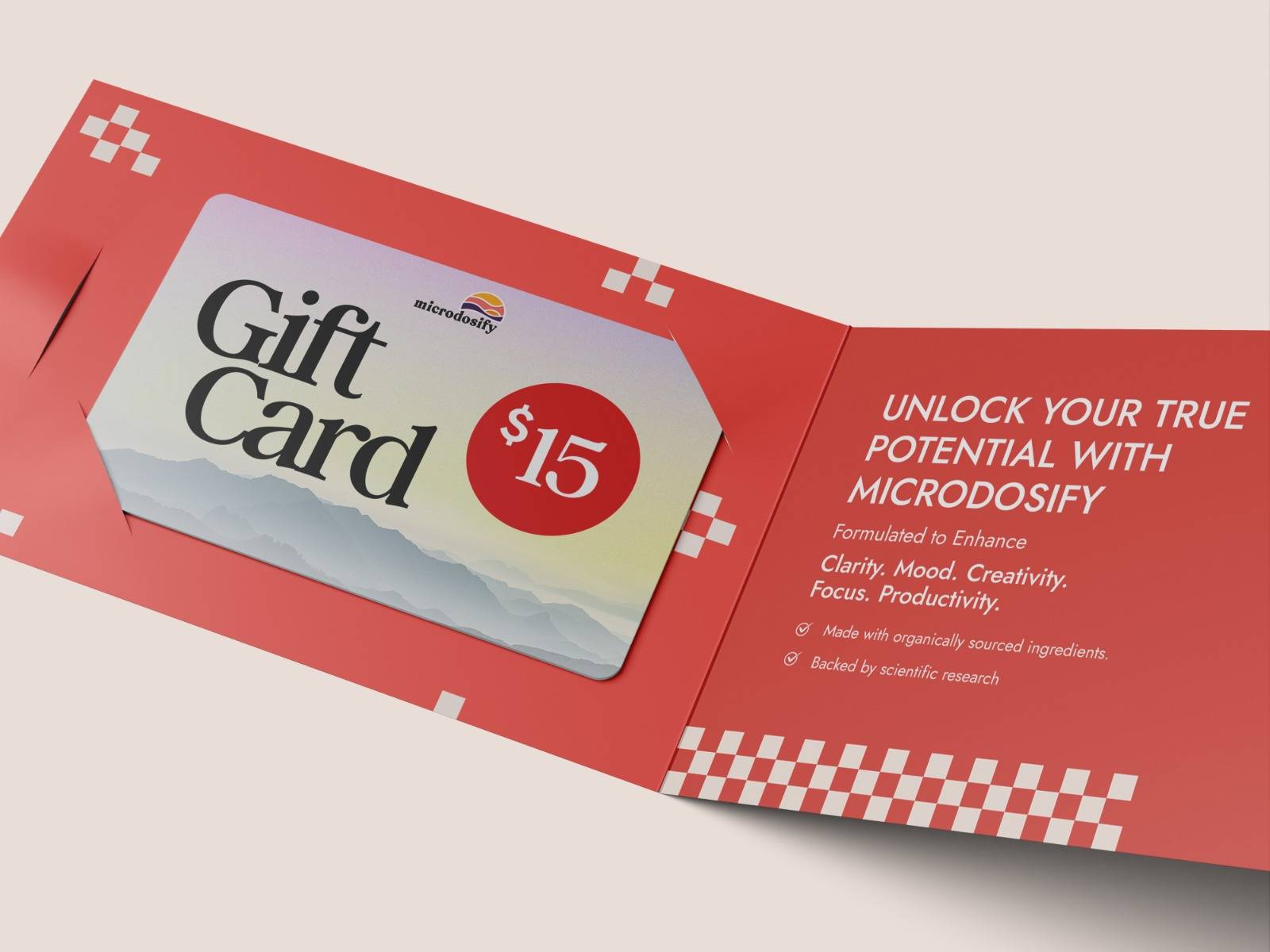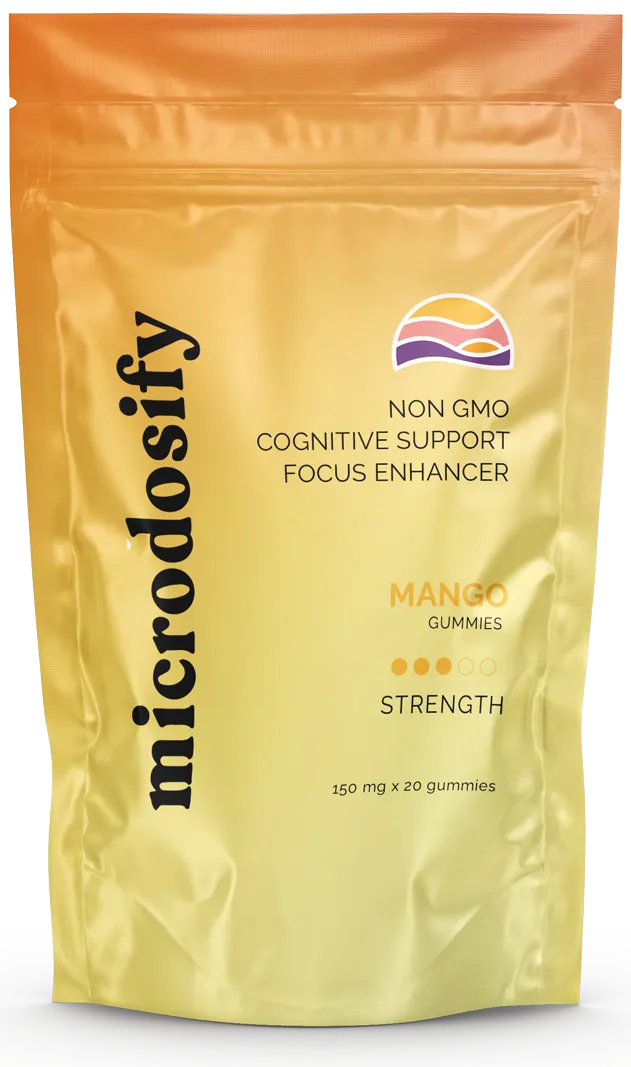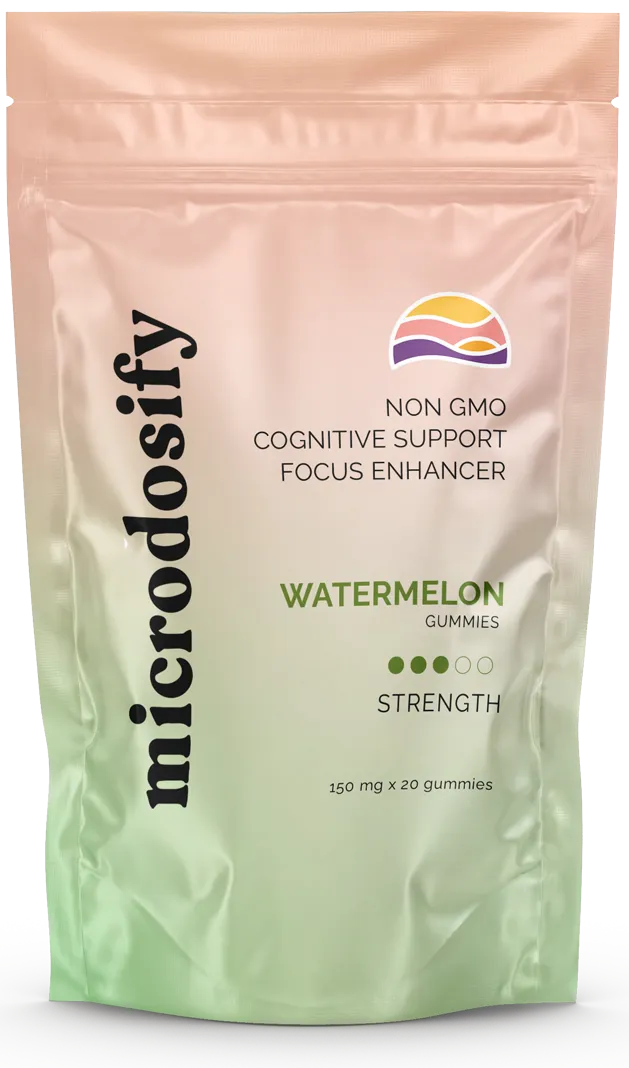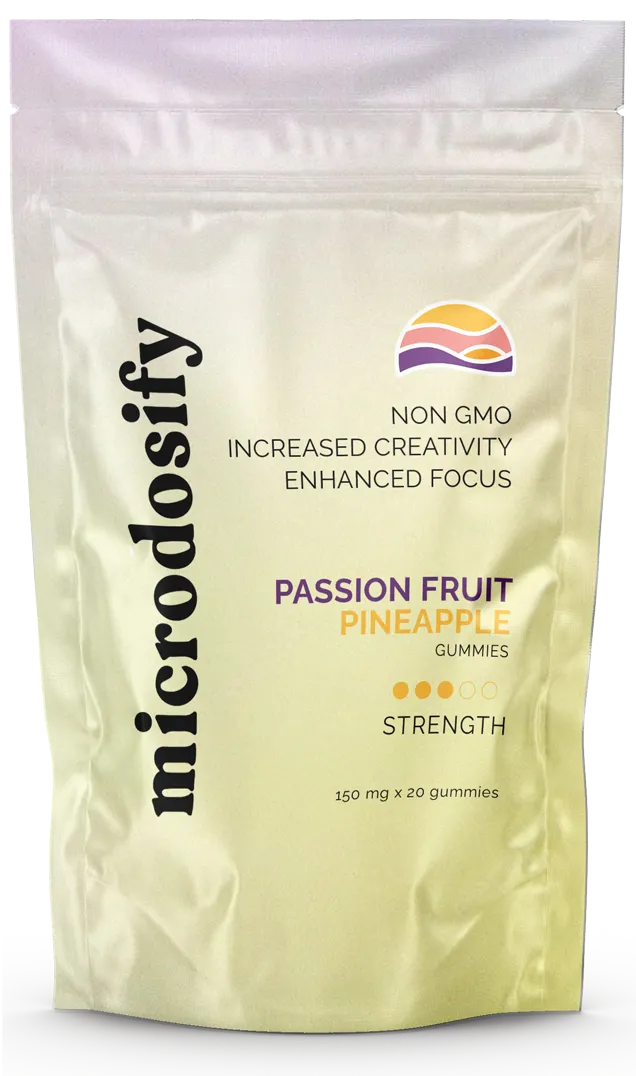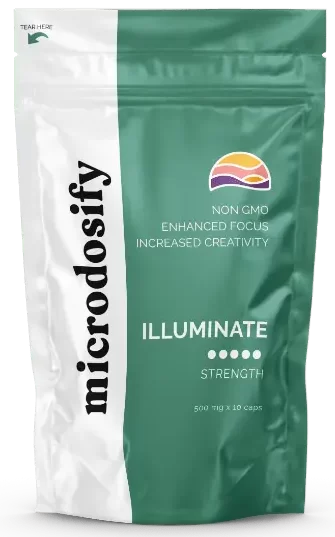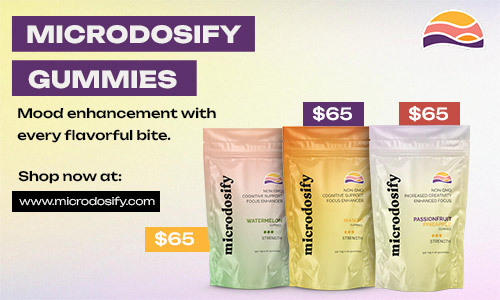Everything You Need to Know About Microdosing Psychedelic Mushrooms
Microdosing is the practice of taking small doses of mushrooms every few days to improve mood, creativity, and focus. A microdose is usually around one-tenth of the amount of a recreational dose.
The intention behind microdosing is not to induce a full-blown psychedelic experience but to leverage the subtle effects of the substance for emotional well-being and personal growth.
While there are thousands of anecdotal reports that support the benefits of microdosing, the science behind the practice is limited but growing. In this article, we will summarize what you might experience while microdosing as well as share the most commonly reported benefits and risks.
Let’s find out more!
What is Microdosing Mushrooms?

Microdosing is the practice of taking small amounts of psychedelic mushrooms such as Golden Teacher, aiming for subtle shifts in perception, rather than hallucinations. Many people feel that microdosing has given them life changing benefits; however the science is still in its infancy with mixed results from studies.
For most people, a microdose will fall between the range of 50mg – 250mg of dried psilocybin mushrooms. The dose that is best for each person will vary based on their intention and is often referred to as their sweet spot. To see what dose might be best for you, check out our guide here.
To get the most benefit, many people prefer to microdose every few days for a period of 4-6 weeks before taking a small break. The most common schedules for microdosing are referred to as protocols.
What is a Microdosing Protocol?
A microdosing protocol refers to a schedule of how frequently to take your microdose. It is important not to microdose everyday because many experts believe that you can build tolerance to microdosing mushrooms. Additionally, the long-term impact of taking psilocybin every day is unknown.
The two most well-known protocols include the Fadiman Protocol and the Stamets Protocol:
The Fadiman Protocol involves microdosing every third day, with two days off in between doses. It is most frequently recommended for beginners and allows for a contrast between normal days and microdosing days.
The Stamets Protocol, suggested by mycologist Paul Stamets, recommends a schedule of microdosing four days in a row and taking three days off. Additionally, this protocol recommends combining your psilocybin mushrooms with Lion’s Mane mushroom and Niacin (vitamin B3).
Paul Stamets’ theory is that this combination and schedule will promote neurogenesis and neuroplasticity. Niacin is included to enhance the delivery of mushroom compounds throughout the body.
Want to learn more? Check out our ultimate guide to microdosing protocols here.
What does Microdosing Mushrooms feel like?
Microdosing mushrooms often feels like just “having a really good day”. The experience is much more subtle than working with mushrooms in high doses. Many people describe their microdosing experience as:
- Slightly uplifting
- The world feels the same, but just a little brighter
- Increased sense of awareness
- Time seems to slow down just enough to be more present
- Sharper, more clear mindset
Why Microdose Psychedelic Mushrooms?
Microdosing psychedelic mushrooms may offer a lot of health and mental benefits. Advocates believe it can enhance creativity and overall well-being. Scientists are also investigating the practice for its potential to support symptoms of depression and anxiety..
Ultimately, people choose to microdose for many reasons. Below, we outline the top ten most reported benefits of microdosing psychedelics.
8 Benefits of Microdosing Psychedelics

The most reported benefits of microdosing psychedelics include improved mental health, enhanced brain function, increased creativity, improved focus, support for shifting habits, mindfulness, personal growth, and improved well-being.
1. Improved Mental Health
- A study published on nature.com in 2021 suggests that microdosers report lower levels of anxiety and depression than non-microdosers.
- Many people are turning to microdosing as an alternative to traditional pharmaceuticals such as SSRIs
- If transitioning off of SSRIs, it is incredibly important to do so with the support of a qualified psychedelic friendly professional (we highly recommend The Spirit Pharmacist)
2. Enhanced Brain Functioning
- Microdosers often report improved cognitive abilities including the ability to solve problems with more ease.
- A preliminary study on microdose.me on those that combined their mushroom microdose with Lion’s Mane and Niacin did show that those in older age groups had small, but measurable improvements to their cognition.
3. Increased Creativity
- Many microdosers claim a boost in creativity and access to novel ideas.
- This may include an enhanced ability to think outside the box and foster innovative thinking.
4. Improved Focus and Concentration
- Microdosing may help individuals maintain focus, increasing productivity and reducing distractibility.
- Preliminary results from a study out of Maastricht University in the Netherlands suggest that microdosing may especially be supportive in improving focus in those with ADHD.
5. Support for Quitting Addictive Habits
- Anecdotal reports suggest that microdosing may assist in overcoming habits such as smoking or excessive alcohol consumption.
- Studies from the 1950’s showed the high doses of psychedelics may be effective in supporting those with addiction. To date, no studies have been done on microdosing and addiction.
6. Mindfulness and Self-Reflection
- Microdosing may facilitate an enhanced sense of mindfulness and self-awareness.
- This can provide a potential for deeper introspection and reflection.
7. Shifts in Perspective Leading to Personal Growth
- Microdosing may trigger a shift in mindset and perspective, allowing individuals to reevaluate their values and priorities.
- In turn, this may provide strong potential for personal growth, leading to a more meaningful and fulfilling life.
8. Improved Well-Being:
- Many microdosers report reduced stress and an easier ability to go with the flow as outcomes of their practice
- This can lead to a greater sense of optimism and appreciation of life.
It’s important to note that many of the commonly stated benefits of microdosing psychedelics are based on anecdotal evidence or personal reports from individuals.Further scientific research utilizing placebo-controlled designs is crucial for validating these claims and understanding the full potential of microdosing.
Side Effects of Microdosing Mushrooms

Microdosing mushrooms can have side effects including headaches, stomach discomfort, insomnia, increased anxiety, and increased heightened emotional states. Additionally, some people with pre-existing mental health conditions such as paranoia or who have experienced psychosis should not microdose. We have outlined these risks below:
1. Physical Effects
- Headaches: Some individuals experience headaches, which can range from mild to more severe discomfort.
- Stomach issues: Digestive disturbances such as nausea, stomachache, or gastrointestinal discomfort have been reported by some microdosers.
- Insomnia: Difficulty falling asleep or disturbances in sleep patterns can occur.
- Increased heart rate and blood pressure: Stimulating effects of psychedelics can lead to temporary increases in heart rate and blood pressure.
2. Psychological Effects
- Anxiety and increased stress: Microdosing may lead to heightened anxiety or increased stress levels in some individuals, especially those predisposed to anxiety disorders.
- Worsened mood: While some people report mood enhancement, others may experience negative shifts in mood, including feelings of sadness, irritability, or emotional instability.
- Cognitive disturbances: Some individuals may experience difficulties with concentration, focus, or memory while microdosing.
- Uncomfortable sensations or feelings: Sensory perceptions may be altered in ways that individuals find uncomfortable or disorienting.
3. Risk of Psychiatric Symptoms
- Panic attacks: Some individuals may experience intense panic or anxiety attacks while under the influence of microdoses.
- Paranoia: Microdosing can amplify existing feelings of paranoia or induce paranoid thoughts in individuals who are prone to them. Microdosing is not recommended to those prone to paranoia.
- Psychotic episodes: For individuals with a history of psychotic disorders or a predisposition to psychosis, microdosing can potentially trigger or worsen psychotic symptoms. Microdosing is not recommended for those with a personal or family history of psychosis or schizophrenia.
It is important to note that these side effects can vary widely among individuals, and some people may not experience any negative effects while microdosing. Oftentimes, these side effects are reduced completely by taking a lower dose. However, the risks associated with microdosing should not be underestimated, particularly for those with pre-existing mental health conditions.
Final Thoughts
In summary, microdosing involves taking tiny amounts of psychedelics with the intention of supporting mental and emotional well-being, without experiencing traditional psychedelic effects such as hallucinations or distorted reality.
Its reported benefits have put it in the spotlight as a potential well-being tool, and include improved focus, creativity, and mood regulation. While research is still in its early stages, microdosing shows promise in facilitating neuroplasticity and assisting individuals with conditions like depression and anxiety.
However, caution, dosage accuracy, and reliable sourcing are crucial. Consulting with professionals is advised, especially for those who have or are predisposed to certain conditions such as paranoia. Further research is needed to understand its mechanisms, long-term effects, and risks.
Responsible use, education, and scientific inquiry are essential for maximizing the potential benefits of microdosing and integrating it safely into society.
Sources:
- Three Cases of Reported Improvement in Microsmia and Anosmia Following Naturalistic Use of Psilocybin and LSD by (August 2023) Alexsandra Kovacevich, Jeremy Weleff, Benjamin Claytor & Brian S. Barnett
- Psychedelic Microdosing: What Is It Good For? by (September 2023) Anya K. Bershad
- Stability of psilocybin and its four analogs in the biomass of the psychotropic mushroom Psilocybe cubensis by (February 2021) Klára Gotvaldová, Kateřina Hájková, Jan Borovička, Radek Jurok, Petra Cihlářová, Martin Kuchař
- Magic Mushroom Use: A Qualitative Interview Study of Post-Trip Impacts and Strategies for Optimizing Experiences by (January 2022) Lindsay Shaw, Kerri Rea, Nathan J. Lachowsky & Eric Abella Roth
- Risks and benefits of psilocybin use in people with bipolar disorder: An international web-based survey on experiences of ‘magic mushroom’ consumption by (December 2022) Emma Morton, Kimberly Sakai, Amir Ashtari, M. Pleet, E. Michalak, J. Woolley
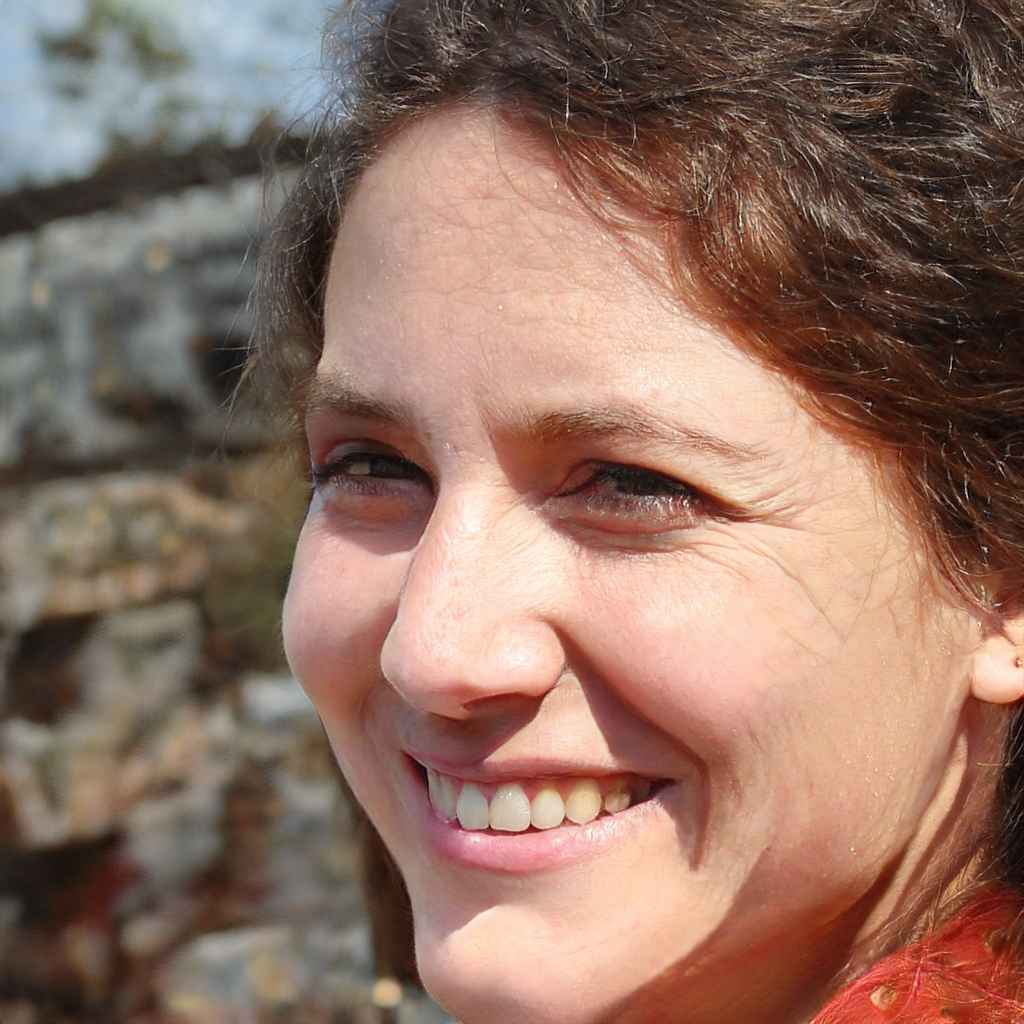
By Rachel Grey
I’m Rachel Grey, a Ph.D. psychologist specializing in psychedelic therapy with psilocybin and natural plant medicines. I obtained my doctorate from the University of Toronto, where I immersed myself in the study of these transformative therapies. With over 10 years of experience, let’s embark on transformative journeys of healing, growth, and self-discovery as we explore the power of psychedelic therapy together.




